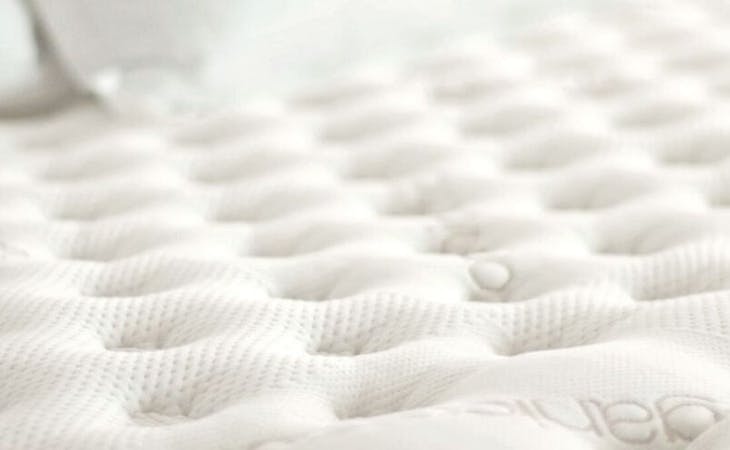There are a lot of things to consider when buying a new mattress. You have to figure out which mattress type to choose, whether that’s innerspring, memory foam, or latex. You also have to determine which mattress size will give you enough space to sleep comfortably without cramping your bedroom.
Another factor, and perhaps the most important, is mattress firmness, as it’s the key to a comfortable night’s sleep.
Mattress firmness guide
Most mattresses come in a range of firmness options, from soft (also called plush) to medium firm to firm.
Read on to learn everything you need to know in order to select the right firmness level for you.
What is mattress firmness?
Mattress firmness is a function of the amount and type of material in the top, or comfort, layer of the mattress, which determines how the mattress feels when you lie down on it. Some brands, particularly boxed beds, sell mattresses with “universal” firmness, which is typically a medium firmness intended to appeal to the widest range of sleepers.
Keep in mind that mattress firmness and mattress support are not the same things. To be supportive, a mattress does not need to be firm. A soft mattress can still be supportive enough if its bottom layers provide enough support for the person’s specific body type.
A good mattress has to provide support for your body, meaning it should promote correct spinal alignment. Support comes from the core of the mattress, rather than from how soft or firm its surface feels. In foam mattresses, support comes from the denser bottom layers of foam, while in innerspring mattresses it comes from the spring system.
How is firmness measured?
While there is no universal measure of mattress firmness, most companies use a scale of 1 to 10, with 1 being the softest and 10 being the firmest. Every manufacturer will have its own scale, and what is considered firm by one will not necessarily feel the same as a firm mattress from another.
Here’s the mattress firmness scale Saatva uses:

What firmness is best for your sleep position?
When choosing the right firmness level for you, take your preferred sleep position into account.
- Side sleepers: If you sleep on your side, your mattress needs to be soft enough to cradle your hips and shoulders and promote the correct spinal alignment. According to Joe Auer, editor of the mattress review site Mattress Clarity, “a good mattress for side sleeping should conform to your body, taking the pressure off your hips and shoulders and aligning your spine so that your muscles can relax.”
- Back sleepers: Back sleepers will do best with a medium firm mattress. According to Michael Breus, PhD, Los Angeles sleep disorder specialist, a mattress that’s too soft will cause your back to sink into your bed too much, but a mattress that’s too firm will not provide enough support in the lumbar area.
- Stomach sleepers: If you’re one of the 7% of Americans sleeping on their stomach, you’re most likely tired of hearing that this isn’t the best sleeping position as it can throw your spine out of alignment and cause neck pain. But the good news is that a properly supportive mattress can somewhat mitigate the damage and make you more comfortable. Stomach sleepers will be most comfortable on a firm mattress “that allows your body to maintain the best possible alignment while lying face-down,” says Ben Trapskin, editor of mattress review site Sleep Sherpa. A mattress that’s too soft will pull your midsection down, exaggerating the curve of your lower back. This is especially true for heavier people.
Watch this video to determine how to choose the right mattress firmness for you:
Firmness by mattress materials
Although memory foam tends to have a reputation of being softer than innerspring and latex mattresses, no one mattress type is inherently softer, or firmer, than the other. Mattress firmness has to do with the design and construction of the mattress.
As we explained earlier, how firm a mattress feels comes from the top layers of the mattress, where foams and padding reside. The softer the foams and padding in the upper layers of the mattress, the softer the mattress will feel when you lie down on it. And the firmer the foams and padding in the upper layers, the firmer the mattress will feel.
Also, keep in mind that a new mattress takes time to break in—so while it may feel stiffer and firmer to start, the materials in the top layers of the mattress will soften up over time.
Learn about the differences between mattress firmness and support:
What to consider before buying
Besides your sleeping position, there are additional considerations to take into account when choosing mattress firmness.
- If you sleep with a partner, the two of you might have different sleep preferences. In this case, you may want to consider a mattress like an adjustable air bed. Unlike traditional foam or spring mattresses that have a uniform firmness level, adjustable air beds contain individual air chambers that can be inflated or deflated to achieve your preferred level of firmness. Another option is a split king mattress, which consists of two twin XL mattresses side by side, allowing each sleeper to have a mattress with their own preferred firmness level.
- Certain health conditions require a particular level of firmness or a particular sleeping position. If you have sleep apnea or acid reflux, you may find relief by sleeping on your side, and side-sleeping works best on a softer mattress.
- If you have existing aches and pains, you want to be particularly careful when choosing the firmness level of your mattress, as the wrong mattress can make things worse. That is especially true if you suffer from back pain, as your back needs to be able to relax during the night. The right mattress, in this case, will depend on your preferred sleeping position but must ensure your spine is perfectly aligned and your back supported. If you suffer from hip pain, you need a mattress that’s cushioned enough to conform to your body shape but that’s still fairly firm to support your hips. Back sleeping is also considered best for people who suffer from hip pain, and back sleepers should sleep on a medium-firm mattress.
- Always take into account your body type when choosing your mattress firmness level. Heavier people do better on slightly firmer mattresses, as a firm mattress will be able to keep their spine aligned without sagging, while lighter people will be more comfortable on slightly softer mattresses.
- If you’re not happy with the firmness of your current mattress, there are ways you can make it softer or firmer that don’t involve buying a brand-new bed. One of the easiest things you can do is use a mattress topper. A mattress topper can be made of memory foam or latex or can be filled with down or down alternative. They are usually 1-3 inches thick and come in different levels of firmness. The different materials of mattress toppers will have different properties. Memory foam toppers provide great pressure relief and come in several different levels of firmness, depending on the density of the foam. Latex toppers will have a “springier” feel to them, and down or down alternative toppers will give you an extremely soft, even cloud-like surface to sleep on.
For more advice on choosing the right mattress firmness for you, read our guide to plush vs. firm mattresses.










